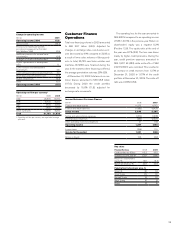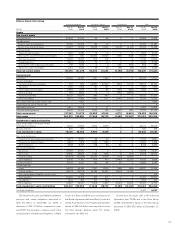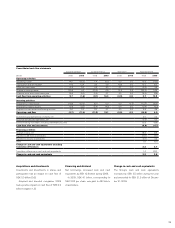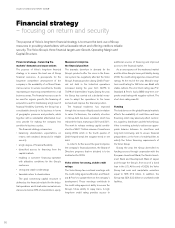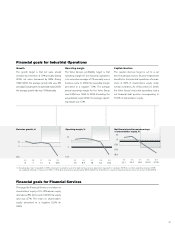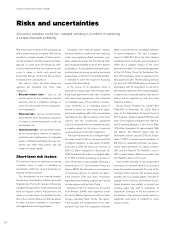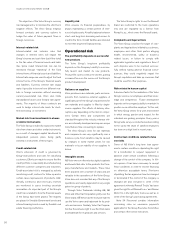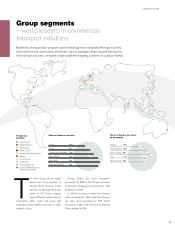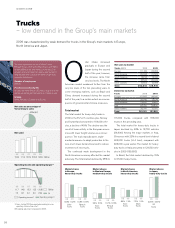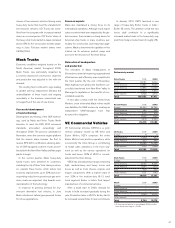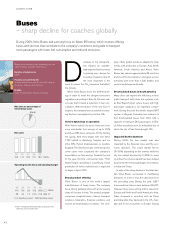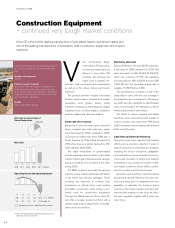Volvo 2009 Annual Report Download - page 39
Download and view the complete annual report
Please find page 39 of the 2009 Volvo annual report below. You can navigate through the pages in the report by either clicking on the pages listed below, or by using the keyword search tool below to find specific information within the annual report.
08
7.8
10.9
03
8.0
9.1
04
7.3
9.1
05
7.5
9.2
06
7.4
9.3
07
6.8
9.3
02
9.7
9.1
01
10.3
9.2
00
9.2
8.4
SEK/USD
SEK/EUR
SEK/100 JPY
8.66.7 6.5 6.7 5.8 5.87.37.98.2
Source: Reuters
09
7.2
10.4
7.9
Sweden
Europe
The U.S.
06
3.7
3.8
4.8
07
4.3
4.3
4.0
08
2.4
2.9
2.2
01
5.1
4.8
5.0
02
5.3
4.8
4.5
03
4.6
4.1
4.0
04
4.4
4.0
4.2
05
3.4
3.4
4.3
00
5.4
5.3
6.0
Source: Reuters
09
3.4
3.4
3.8
%
%
%
Currencies Interest rates in Sweden, Europe and the U.S.
Government bonds, 10 year benchmarks.
External-related risk
The commercial vehicles industry
is cyclical
The Volvo Group’s markets have undergone
signicant changes in demand as the general
economic environment has fluctuated. Invest-
ments in infrastructure, major industrial projects,
mining and housing construction all impact the
Group’s operations as its products are central
to these sectors. Adverse changes in the
economic conditions for the Volvo Group’s
customers may also impact existing order
books through cancellations of previously
placed orders. The cyclical demand for the
Group’s products makes the nancial result of
the operations dependable on the Group’s
ability to react to changes in demand, in par-
ticular to the ability to adapt production levels
and production and operating expenses.
Intense competition
Continued consolidation in the industry is
expected to create fewer but stronger com-
petitors. Our major competitors are Daimler,
Paccar, Navistar, MAN, Scania, Caterpillar,
Komatsu, Cummins and Brunswick. In recent
years, new competitors have emerged in Asia,
particularly in China. These new competitors
are mainly active in their domestic markets,
but are expected to increase their presence in
other parts of the world.
Prices may change
The prices of commercial vehicles have, at
times, changed considerably in certain markets
over a short period. This instability is caused
by several factors, such as short-term varia-
tions in demand, shortages of certain compo-
nent products, uncertainty regarding underlying
economic conditions, changes in import regu-
lations, excess inventory and increased com-
petition. Overcapacity within the industry can
occur if there is a lack of demand, potentially
leading to increased price pressure.
Extensive government regulation
Regulations regarding exhaust emission levels,
noise, safety and levels of pollutants from pro-
duction plants are extensive within the industry.
Most of the regulatory challenges regarding
products relate to reduced engine emissions.
The Volvo Group is a signicant player in the
commercial vehicle industry and one of the
world’s largest producers of heavy-duty diesel
engines. The product development capacity
within the Volvo Group is well consolidated to be
able to focus resources for research and devel-
opment to meet tougher emission regulations.
Future product regulations are well known, and
the product development strategy is well tuned
to the introduction of new regulations.
Financial risk
In its operations, the Volvo Group is exposed to
various types of nancial risks. Group-wide
policies, which are updated and decided upon
annually, form the basis of each Group com-
pany’s management of these risks. The object-
ives of the Group’s policies for management of
nancial risks are to optimize the Group’s cap-
ital costs by utilizing economies of scale, to
minimize negative effects on income as a
result of changes in currency or interest rates,
to optimize risk exposure and to clarify areas
of responsibility. Monitoring and control that
established policies are adhered to is continu-
ously conducted. Most of the Volvo Group’s
nancial transactions are carried out through
Volvo’s in-house bank, Volvo Treasury, that
conducts its operations within established risk
mandates and limits. Credit risks are mainly
managed by the different business areas.
The nature of the various nancial risks and
objectives and the policies for the manage-
ment of these risks are described in detail in
notes 36 and 37. Volvo’s accounting policies
for nancial instruments are described in note
1. Various aspects of nancial risk are
described separately in the following para-
graphs. The overall impact on a company’s
competitiveness is also affected however by
how various macro-economic factors interact.
Currency-related risk
More than 90% of the net sales of the Volvo
Group are generated in countries other than
Sweden. Changes in exchange rates have a
direct impact on the Volvo Group’s operating
income, balance sheet and cash flow, as well
as an indirect impact on Volvo’s competitive-
ness, which over time affects the Group’s
earnings. Currency-associated risk in Volvo’s
business operations relates to changes in the
value of contracted and expected future pay-
ment flows (commercial currency exposure),
changes in the value of loans and investments
(nancial currency exposure) and changes in
the value of assets and liabilities of foreign
subsidiaries (currency exposure of sharehold-
ers’ equity). In addition, currency movements
can affect Volvo’s pricing of products sold and
materials purchased in foreign currencies.
Since Volvo has substantial manufacturing
operations in Sweden and generates a sub-
stantial portion of its revenues in currencies
other than the Swedish krona, Volvo’s earnings
in Swedish kronor could be positively affected
in the short-term by a depreciation of the
Swedish krona against other currencies.
35


